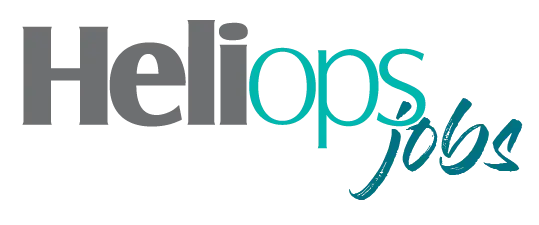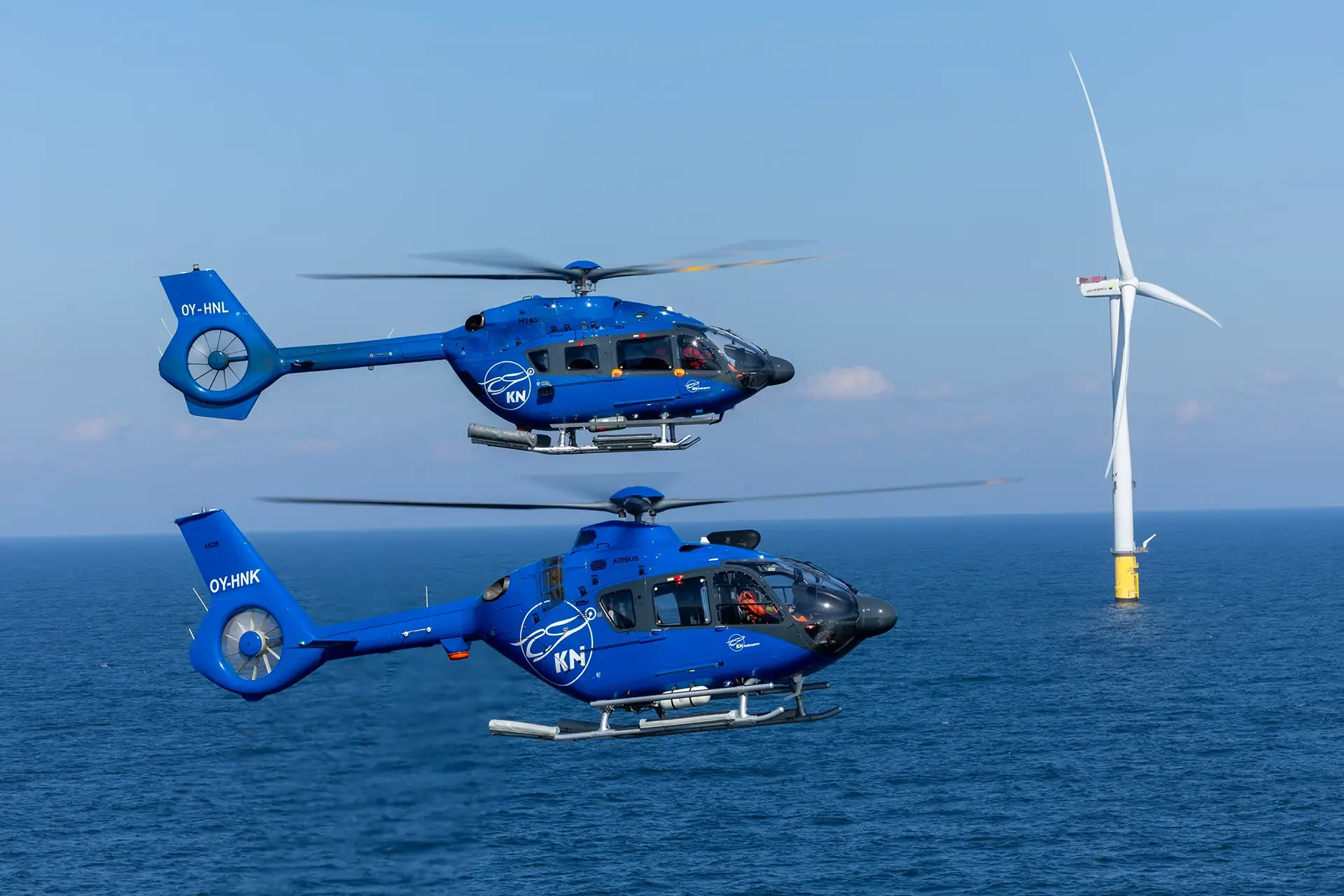Windfarms are a major feature of the European land and seascapes, with an ever-increasing number of the massive turbines appearing both on and offshore, some with rotor diameters of over 230 meters. Installing, maintaining and servicing the structures and accompanying substations demands efficiency, versatility and adaptability; characteristics that ideally suit the capabilities of helicopters.
Danish company KN Helicopters was established in 2013, named for the first initials of founders Niels Kjeldahl and Karin Granhoj. Kjeldahl left previous employer UniFly when it became apparent that that Kjeldahl wanted to go in a different direction. He moved to Siemens in 2012, where he was the helicopter specialist for that company’s work on logistical product development and supplemented that with some VIP flying for a small privately-owned fleet of fixed and rotary wing types. He then transitioned into some HEMS work and reconnected with Granhoj. Granhoj had worked for UniFly but left to take on more responsibility and implement a new roster for sea pilot transfers with Danish state pilotage company, DanPilot. After leaving DanPilot, she worked for Falck, establishing the first Danish HEMS operation, including obtaining the original AOC and setting up the first HEMS base.
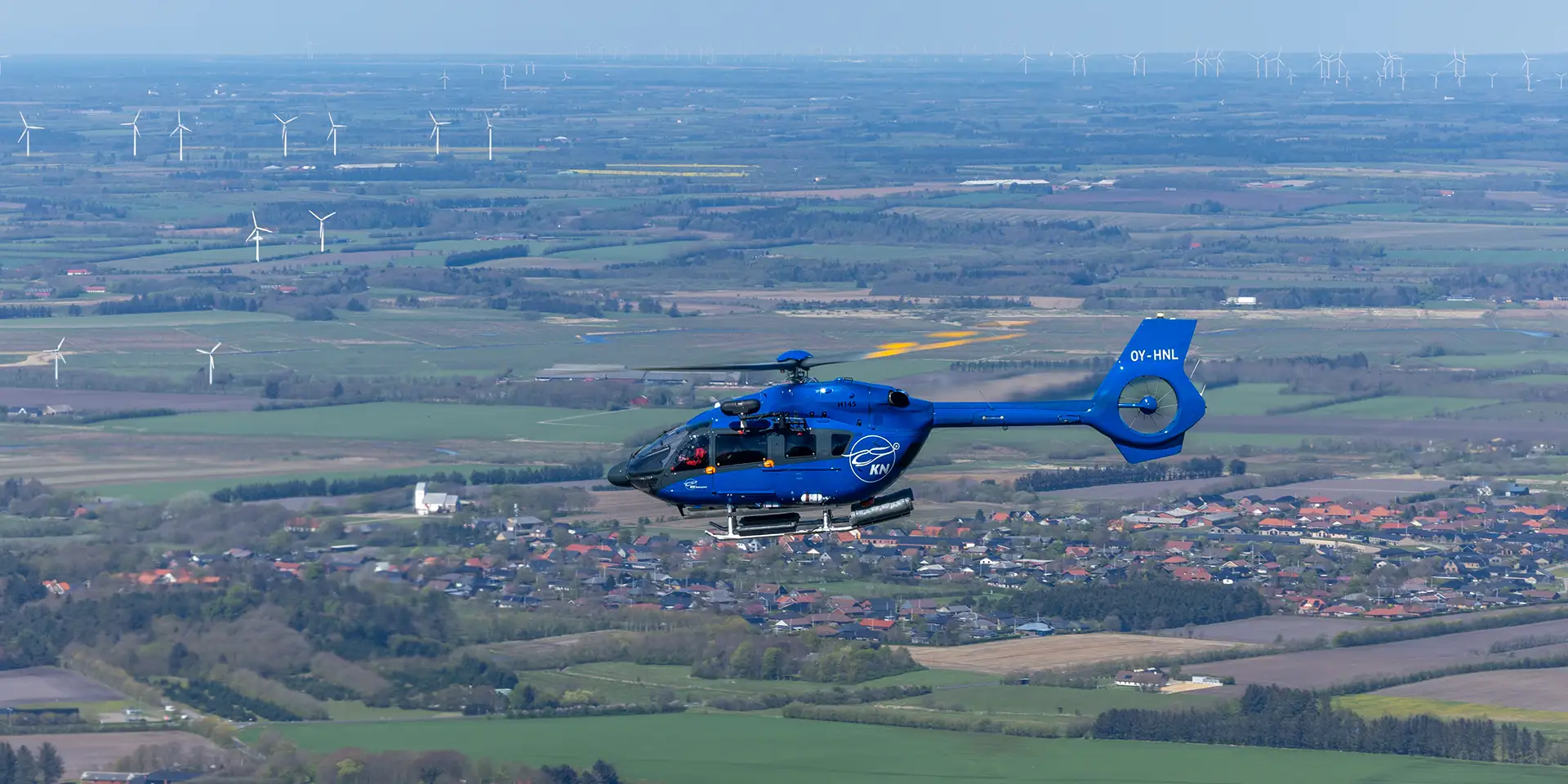
Granhoj commented that she and Kjeldahl had both been considering for some time the possibility of establishing a helicopter company that was different from any established operators and could offer more flexibility to carry out the type of work they now specialize in. “That was our main driving motivation,” added Kjeldahl. “We wanted to build a company that was a nice place to be but totally professional and doing what we do very well. The people we have working here are more like family than employees. We established the company in 2013 but didn’t really get traction until about 2016.”
The Present
KN now employs around 25 people including eight pilots, seven hoist operators, three dedicated mechanics, ground handling staff and administration personnel. It provides helicopter services primarily to the green energy sector, offering crew changes to offshore installations and vessels, hoist operations to wind turbines and vessels, inspections and audits of infrastructure, helicopter external sling load operations (HESLO) in environmental sensitive areas and VIP-flights. KN can also offer their expertise in building helicopter bases with operational facilities that include a helipad and fuel tank system. In the first days of the operation after the company’s first successful bid however, the operation was very limited in scope.
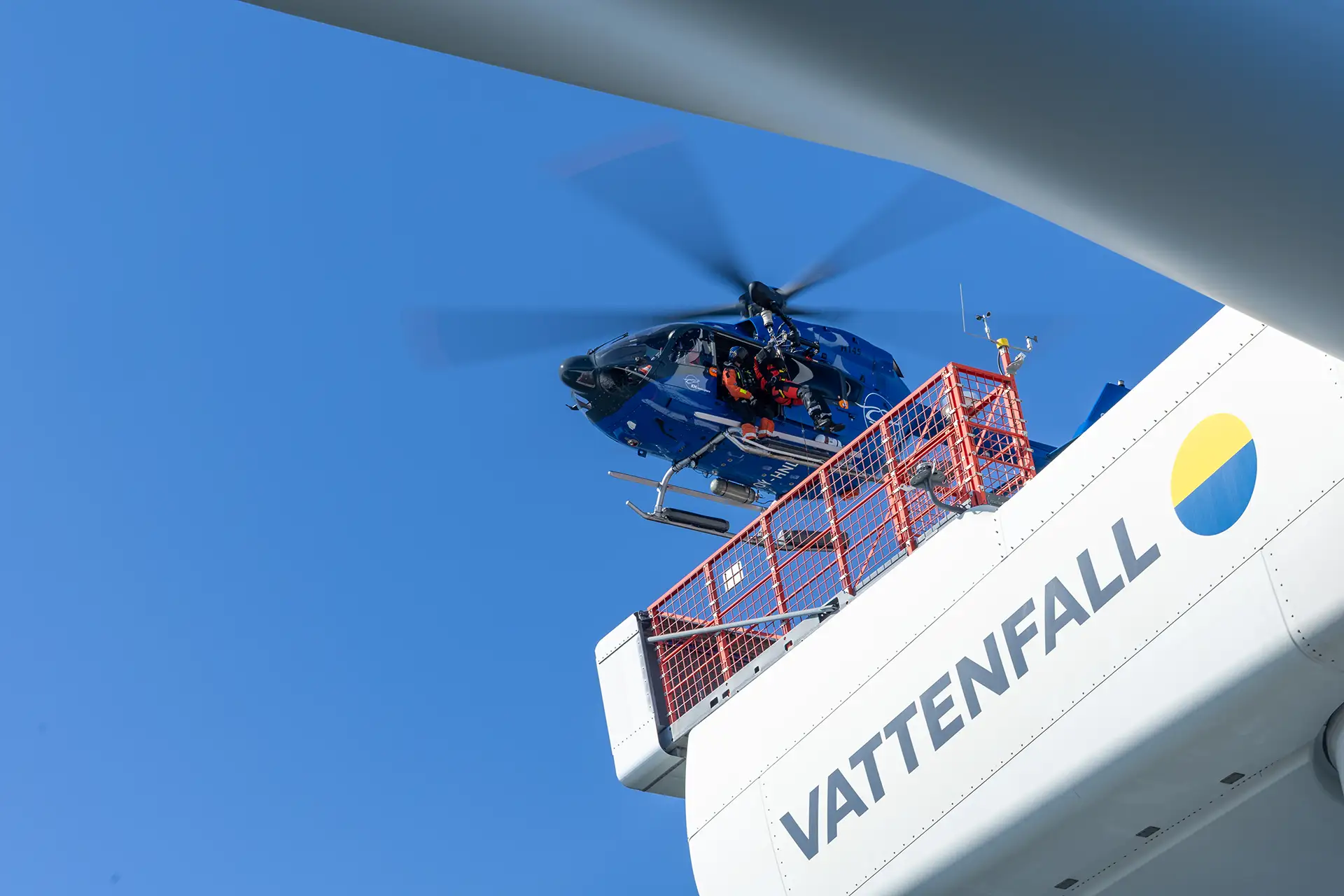
Kjeldahl pointed out that there were few contracts to bid for and still fewer that would accept a proposal from a first-time bidder, so during that time he was still doing some HEMS work and Granhoj was working on the aviation approvals for the Danish Home Guard. The network of aviation contacts that the pair had built up over their years in the industry helped to garner the first success, which came when they had the opportunity to bid on a brand-new contract for daily personnel transfers during the completion and commissioning of two substations in the state-owned grid, so their success didn’t push any other operator out of any existing work. “That was a good first contract as it was relatively uncomplicated and required less specialized aircraft,” Kjeldahl noted.
Although KN Helicopters was a relatively unknown company, both Kjeldahl and Granhoj were quite well known and well regarded from their previous histories in the local industry, which spanned around 20 years and made the bid a much more viable proposition. “The authorities also knew us both and that we never did less than the best,” commented Granhoj. Kjeldahl had filled flight operations manager, training manager and ground operations positions in the past with various companies so his experience and expertise were well established. Nevertheless, competing companies appealed KN’s successful bid, which delayed their start.
When their bid was eventually confirmed, the pair were left with just four weeks to finalize the AOC, bringing on the necessary staff and
hiring a privately owned EC135-T2+. Granhoj’s experience in working on other organizations’ AOCs came in handy and everything was in place
for the commencement of the contract, which resulted in six months of flying for the first substation, followed by almost a year-long gap
before another six months work on the second site, including the building of a heliport complete with fuel facilities, a hangar and crew
cabins, specifically for that contract. That initial contract eventually extended to a full-time contract for substation support that KN
still holds. The private EC135 that KN first hired received a refurbishment and upgrade during the year after the company’s first six-month
stint, including upgrading to dual Garmin 750s and the fitting of hoist provisions, making it an excellent back-up aircraft for subsequent
work and it is still included in the KN fleet today.
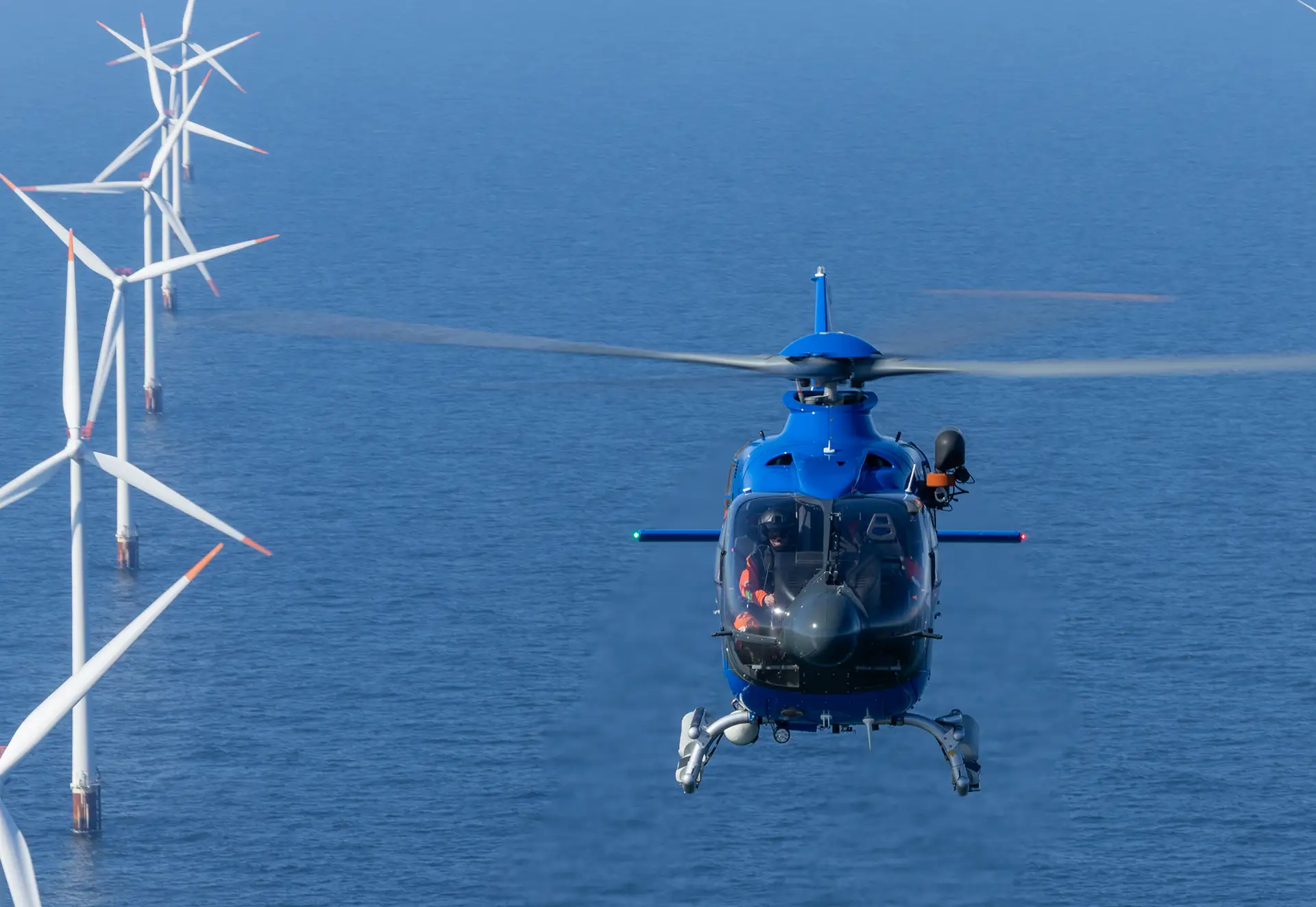
Building the Contract Base
With everything in place, proof of concept established, and the first contract being serviced, KN was in a much better position to bid on subsequent tenders and their next bid was successful, which was a four-year agreement for crew transfers and hoisting supplies for work on another windfarm further south. “By then we had managed to establish relationships with other private aircraft owners that wanted their aircraft on an AOC and getting a bit more use. That enabled us to bid with an EC135 for hoisting and an AW139 for crew transfers, which was a major factor that helped us win that tender with Vattenfall,” Kjeldahl advised.
Additional contracts meant additional aircraft and pilots were required so KN went looking for a used EC135 and hired another experienced
135 pilot. “Luckily, we had three months to find one before the contract commenced in 2017 and it was quite a task to locate one that was
available and configured for what we needed. We managed to find one in Germany, and had it modified to what we needed but had to hire
another aircraft for two months until it arrived, to make sure we were on time with delivery of the contract,” Kjeldahl recalled. That
initial four-year contract was the beginning of a longer relationship with Vattenfall, who became KN’s first hoist customer and still use
KN for their helicopter services. Vattenfall currently hires KN’s H145 for both hoisting and crew transfer work, after a subsequent 2021
tender required two-pilot operations for hoisting and it also hires the H135 for a separate contract. It is currently KN’s biggest
customer, with operations to multiple sites and KN currently operates for three major windfarm companies, along with the original
substation contract.
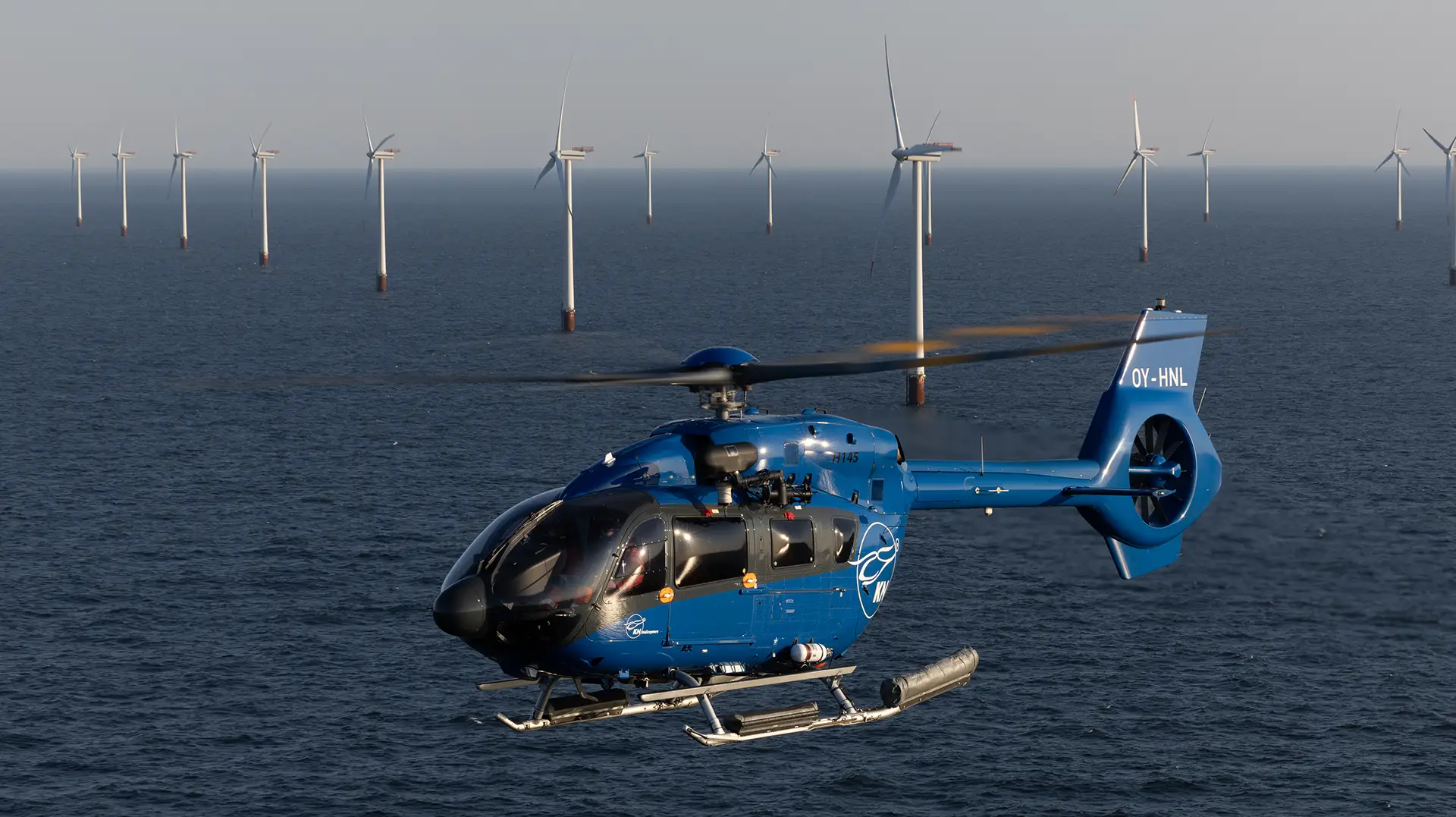
Airbus Choice
Kjeldahl believes the Airbus machines have been the right choice for KN’s needs. “Airbus delivers a very reliable product. It’s not the cheapest but it’s reliable and we’ve been able to perform our operations because of the support we’ve received.” Reliability is a keystone of the operation, with the aircraft enduring somewhere in the vicinity of 10,000 cycles annually. There is no hoist option other than Goodrich on the Airbus machines, but Kjeldahl reported that the Goodrich hoists have been performing extremely well in general. The H145 was converted from a -D2 to a -D3 specification, primarily to obtain the improvement in payload, as operating in the two-minute OEI window does limit maximum payload and makes every kilogram of extra capacity valuable.
Demanding Work
Hoisting personnel and supplies are demanding, highly specialized tasks and Kjeldahl has flown extensive sling and hoist work between 2002 and 2012. He had to update the procedures to incorporate the latest knowledge and best practice, but this was not a great challenge as he had written Denmark’s first ever procedures for such work. He explained that the major companies for which KN operates now often use framework agreements that make for simplified contracting, specifying contract fixed terms or ad-hoc work on a consistent basis. “I think that that is largely based on the fact that they have a hard time committing to aircraft usage and even though it’s been proven many times over that helicopters are extremely versatile and valuable assets for windfarms, there seems to be an attitude in some quarters that they are somewhat exotic, expensive and unnecessary,” Kjeldahl explained.
Despite these apparent misgivings, helicopter access is crucial and particularly with the offshore farms in the North Sea, helicopters are often the only viable transport and support option when high seas make boat access problematic or impossible. Their speed and precision also make them a surprisingly cost-effective option when time is of the essence. “A full-time crew change helicopter is around fifty percent more expensive than a full-time crew transport vessel, but only around one fifth of the cost of the large turbine servicing vessels,” commented Kjeldahl. “However, we are a sailing nation and there is a huge reluctance towards helicopters, unfortunately.”
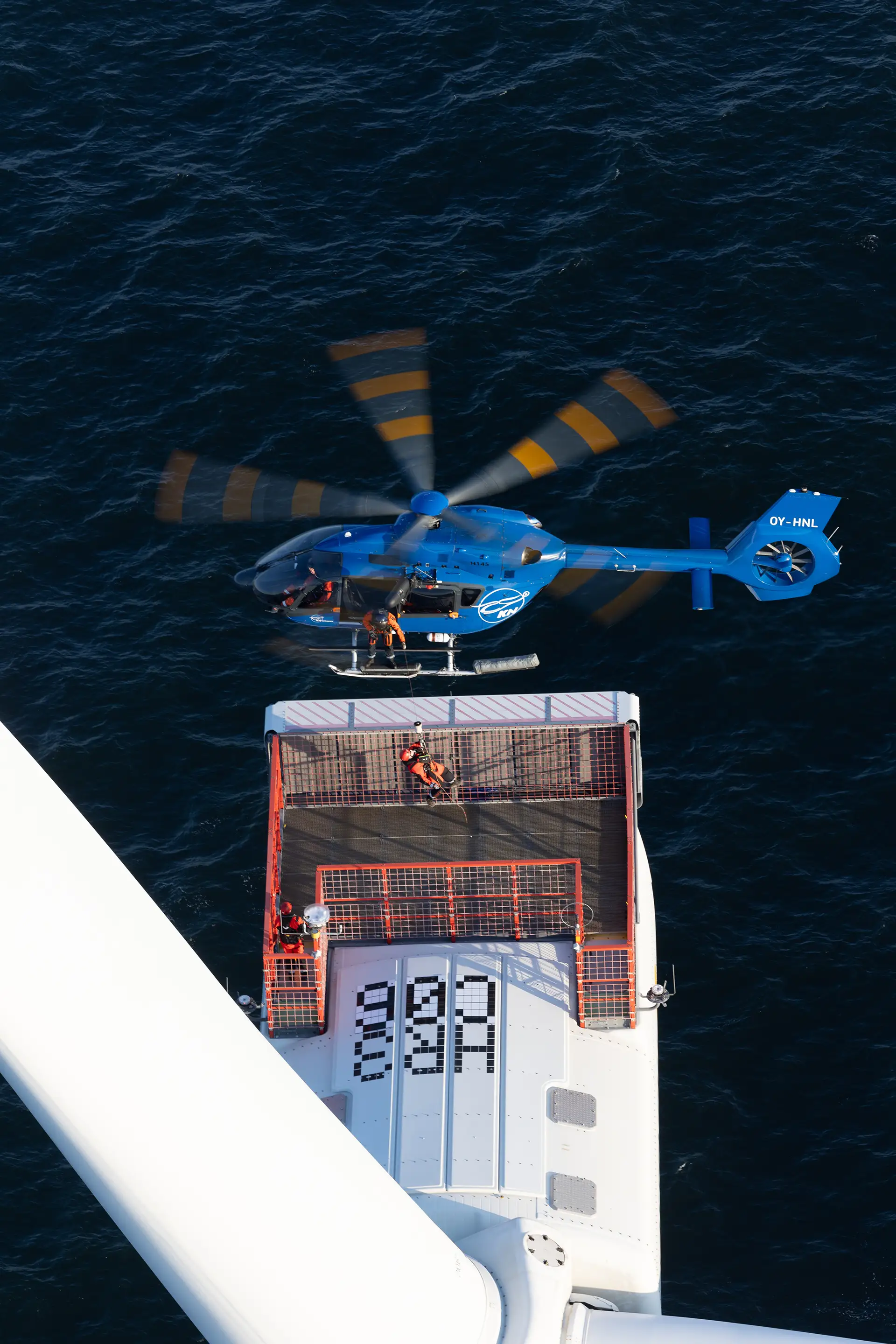
Efficiency in Helicopters
Granhoj pointed out that on some of the latest projects, they had saved significant resources for companies that used the helicopters. According to Kjeldahl, some companies typically use helicopters primarily for troubleshooting, transporting repair crews and supplies to turbines that have failed. “When the seas are above 1.5 meters, docking and transfer between a vessel and turbine is not safe so a helicopter is not only faster, but enables work to be done in conditions that would otherwise be necessarily delayed. In the 135 we can operate in up to a sea state 6, which is at about 60kts of wind and around 50kts in the 145. We take them out to fix it and then come back to maintain availability of the turbines, so you have most of them running the whole year round,” he explained. When the sea state is low, most of the work can be serviced by surface vessels and Kjeldahl estimated that they typically fly on about 250 days a year.
“On another project we have provided a scheduled service. That means we do everything with the helicopter that would otherwise be done with a small service vessel, such as changing oil, pressure washing of the turbine, changing components. Whatever is needed for normal service, we fly out everything.” He advised that this project was done as a proof-of-concept, and it established a 20 percent improvement in turbine operational time and a seventy percent reduction in CO2 emissions.
Kjeldahl elaborated, “The speed of the helicopter allowed significant fuel savings and its ability to deliver materiel directly to the top of the turbine eliminated the need to crane it up from a service vessel. The crews were on the turbine for three days so when we flew out in the evening to pick them up, we delivered the necessary supplies for the next day’s work so there were no extra flights.” Although initially skeptical about the longer working hours on the turbines that helicopter transfer enabled, after the project the crews were unanimously enthusiastic about the system, commenting that despite the longer working hours, they were less beat-up at the end of the day, due to eliminating the need to sit for hours on a vessel in heavy seas to access the turbines twenty miles or more offshore. “They told us, ‘If we need to go home, we call you and you’ll be here in seven minutes and then we’ll be home in another seven minutes,” Kjeldahl recalled, then pointing out, “If you put six technicians on a helicopter, they can do as much or more work than twelve technicians travelling by surface CTV.”
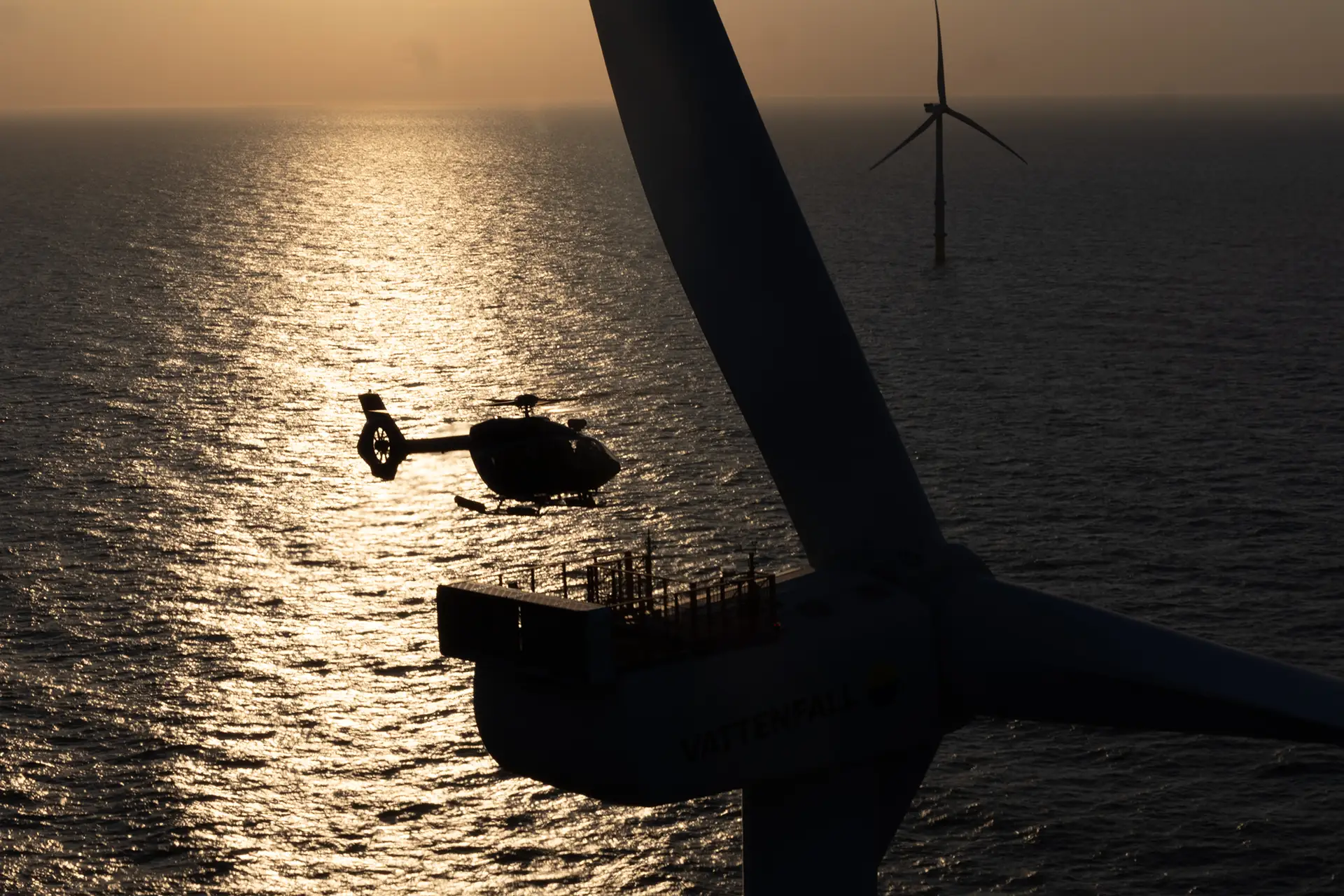
Configuration
Customers specify seating requirements and capacities in their tenders rather than aircraft types, so all KN aircraft have the capabilities required for the work and are approved to carry out radar approaches in poor or foggy weather. The larger H145 is more versatile and capable than its smaller H135 sibling, but cost is an additional factor to be considered when coming to an agreement with the customer on which type they require. This is where the H135 is a stronger choice. Backup aircraft can usually be of either type to ensure availability in the event of AOG outages. All are equipped with Airbus’ Helionix avionics system, including synthetic vision, obstacle warning system and radar that can detect and display the turbine locations. “That shows us where the turbines actually are and we can compare that with our database of where they are supposed to be. Especially when a new windfarm is going up, the data can be faulty or missing,” noted Kjeldahl.
For loads that are larger but not overly heavy or long loads such as cable and pipes, KN will sling-load out to the worksite, again saving time and the need for craning from a surface vessel. From the windfarm company’s perspective, the project proved a significant benefit, with maintenance and repairs being completed faster and more efficiently. The speed of transfer also significantly enhances safety, with a vastly quicker response and transfer time in the event of an accident or medical emergency. The only minor downside to the hugely successful trial is that the benefits were so significant, the windfarm company wants to use helicopters across all its windfarms and therefore would rather not spread the word, so that demand for helicopters does not expand so much that it becomes difficult to access sufficient aircraft for its needs.
Programming
KN is notified of a day’s expected work demand the night before, and it could be for a definite planned flight or flights, or to be on hot
standby in case a currently working turbine should fail. If an aircraft on hot standby is called out, it is in the air within
thirty-minutes. Failures are reasonably common as there are six or seven substations and close to 500 turbines in KN’s area and when one
fails, the windfarm company notifies KN, sends maintenance or repair personnel to the airfield and they depart immediately for the worksite.
Most substations are unmanned but those serving the windfarms 50 to 70 miles out are manned and can include comprehensive facilities for
helicopter operations, including refueling facilities, excellent crew facilities and break rooms, full Wi-Fi and a staffed kitchen serving
hot meals throughout the day. “Operating from out there makes for very short flight times to the turbines and we use 2,500 to 3,000 liters
of fuel a week, whereas a surface vessel uses that much in one day,” Kjeldahl commented.
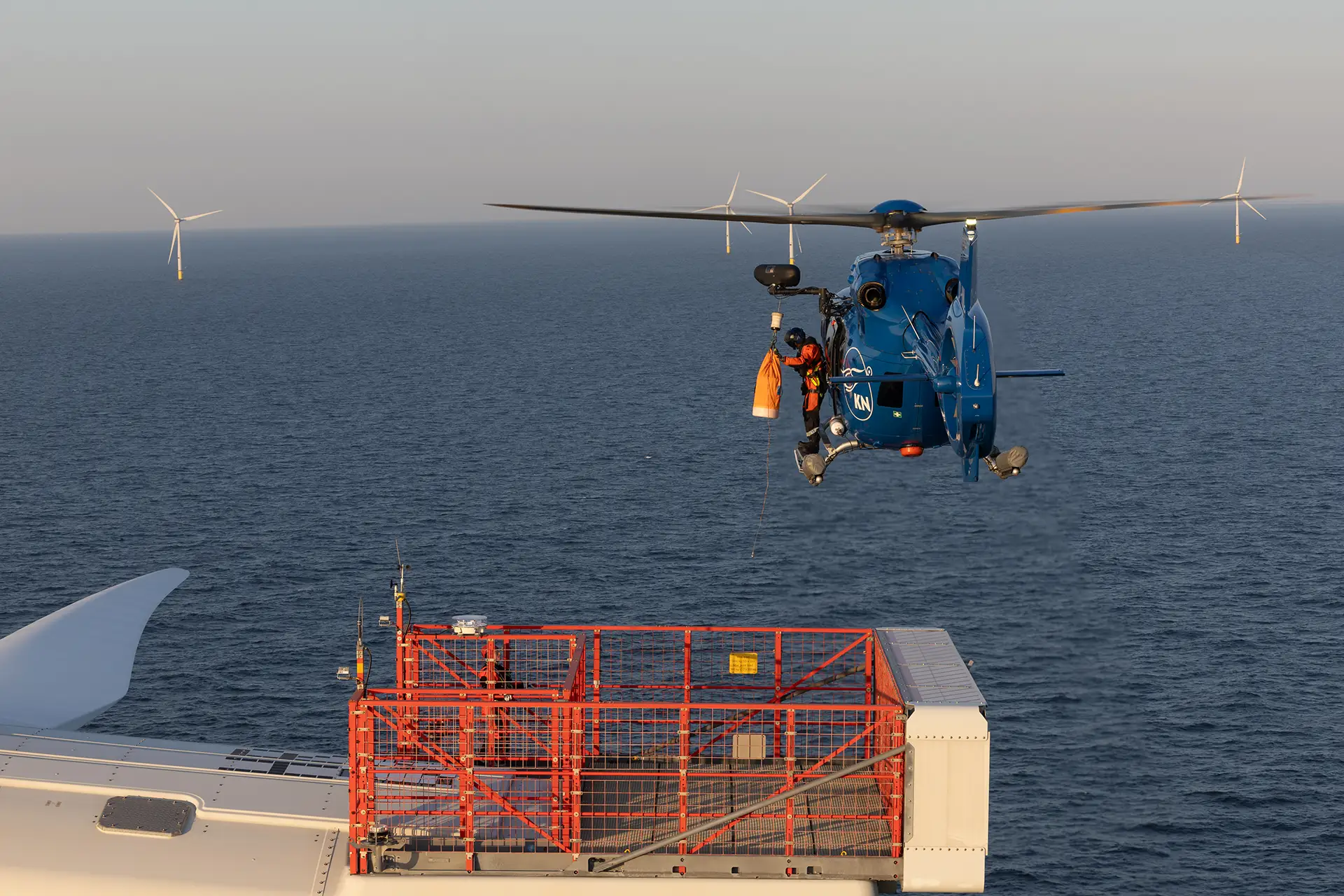
Before a helicopter approaches, a turbine must be stopped, braked and the blades turned ninety degrees away from the wind. A steady green light on the top of the turbine indicates that the hoist requirements for the turbine are fulfilled and if it starts flashing, it indicates that something is no longer within those parameters. The helicopter approaches behind the turbine blades into wind, moves across to the heli-hoist area from behind the turbine, verifies performance when over the heli-hoist area and only then commences hoisting operations. If a turbine loses communication (a ‘dead turbine’) it remains into wind and the blades go into the idle position, still able to rotate. In these circumstances the helicopter can approach from behind the rotor blades, rather than parallel with them and still heading into wind, establish alternate reference points and hoist onto the turbine.
Hoisting is usually carried out at five meters above the turbine’s hoist basket if possible, leaving a safety margin in the event of an engine failure, with the OEM stating an OEI performance of a maximum 3ft drop and maintaining a minimum of 2½ minutes on station on one engine. In the worst case, a five-meter drop for a hoisted passenger is survivable and the short hoist makes transfers quite fast. “A normal day for us is about 40kts of wind, which gives us good performance and the technicians are happy with that,” Kjeldahl advised. “The worst weather we deal with is thick fog, hailstorms or lightning. Aside from us, there are teams in the companies that watch the weather and give around two hours warning of approaching thunderstorms. The technicians can then shelter in a safe zone inside the turbine until it passes, or we can take them off before it arrives.”
On very rare occasions technicians may have to stay on a turbine for several hours or even until the next day if the helicopter operation
is caught by surprise by weather, but Kjeldahl estimated that such an occurrence is only around once every two years. A more common issue
is turbulence from tip vortices if a turbine is operating directly upwind from the turbine being approached. “At 20 to 25kts the turbine’s
rotor tip airflow is close to the stall and the vortices are very strong. You have to be sharp then because you really feel them if you fly
into them,” he commented. Kjeldahl has even been instrumental in the development of the tool bags used on the helicopters, starting with an
idea while flying to the windfarms. The circular bags can be rolled down from the top to minimize size and then secured by carabiner. The
tubular design minimizes spinning under the aircraft and the bags have become so popular that they are now the primary product of a company
that originally specialized in marketing items like caps and backpacks.
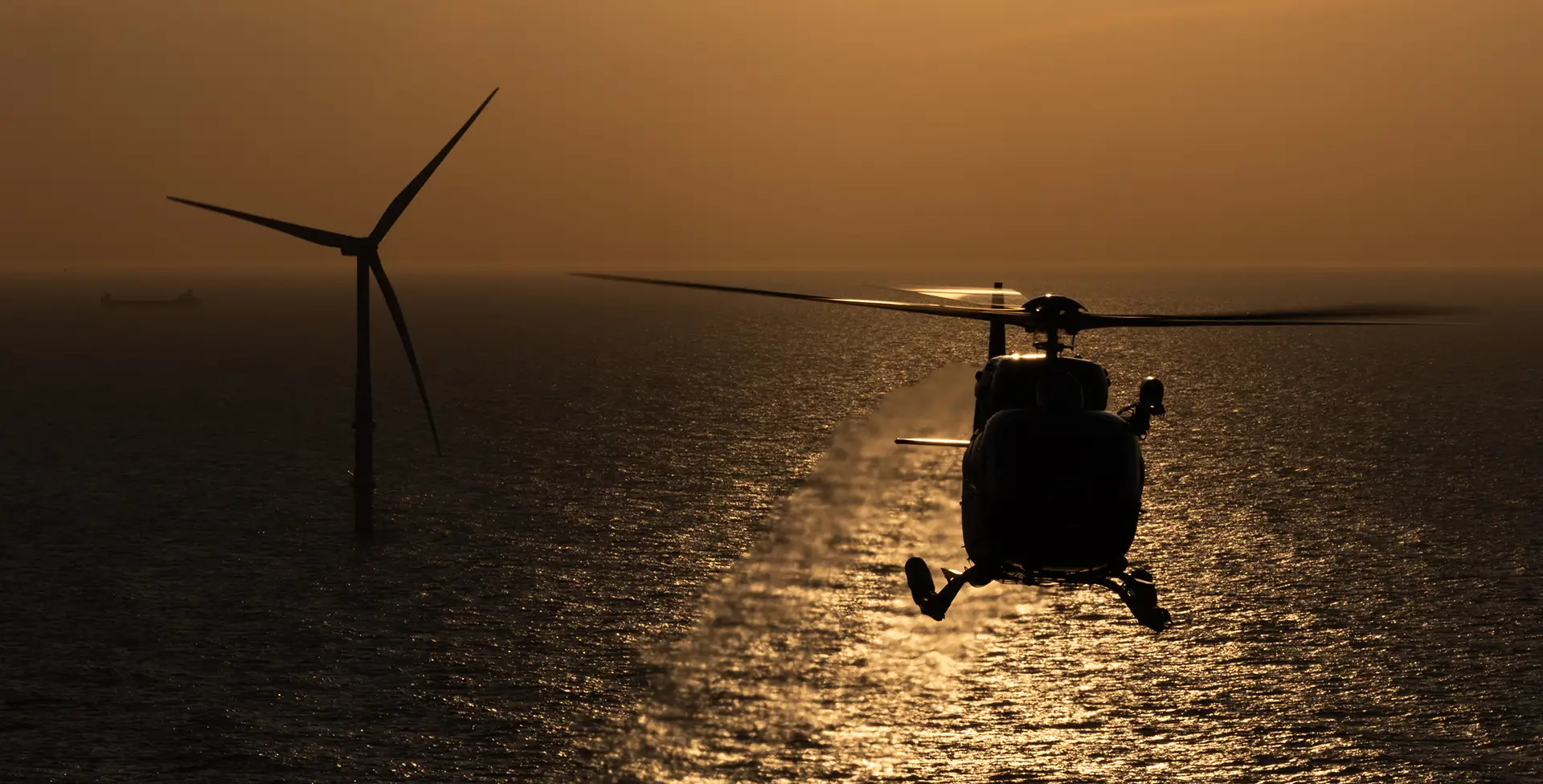
The rate of turbine breakdown is a variable that is affected by such factors as the age of the turbine, the standard of maintenance and who
is maintaining it. Crews turn up to work at about 6:30 am, check the weather, do their planning and confirmation of which turbines are to be
flown to comes in half an hour before departure. “Then we reconfigure the aircraft for the number of seats required and a hoist if
necessary. The aircraft will then either spend the day offshore shuttling personnel and material, or drop them off, return here to Esbjerg
and remain on standby in the hangar,” Kjeldahl explained. “Our primary operation is still out of Esbjerg, from where we are able to provide
services to substations and seven windfarms for three different customers. Most of what we do – around eighty five percent – is hoisting or
sling loading to the turbines and the balance is flying the crew changes. We also have one backup aircraft based at Roskilde, which flies
for some substations on the Baltic.”
Strength
While many windfarm contracts are subsequently lost by the successful bidders after the first or second contract term, KN has gone from strength to strength, with Kjeldahl advising that the company’s first contract grew over the years from 50 hours of hoisting in the first year, to around 800 hours currently. “That’s because the customer has seen the value of the aircraft as they’ve followed us on this path,” he remarked.
The company tries to avoid fixed-price contracts based on a fixed number of flight hours because if flights are restricted by weather or minimal demand, the customer ends up paying more than is necessary for an under-utilized resource. KN has built itself a reputation for under-promising and over-delivering and Granhoj commented, “We have always been very good at listening to the customer and seeking solutions to their specific needs. They know that we deliver.” KN Helicopters’ strength lies in their flexibility and the way they have utilized their extensive experience to specialize in windfarm and green energy support. “It is an advantage to be an owner-operated business. As owners, we have a strong vested interest in the success and expansion of the company and we seek every opportunity to build a strong relationship with the customer,” Kjeldahl stated. “We have to find solutions that make it successful for the customer because if it’s not a success for them, it’s not a success for us.”
More Windfarms?
A barrier to increased electricity production from additional windfarms is the existing power grid’s capacity to accept and distribute the energy. Granhoj said that lines to Germany, Norway and Sweden allowed for the sale of excess power but they are already at or over their capacity and incapable of funneling additional energy from increased production. “More windfarms will mean more contracts that we can bid on, but it’s been a struggle the whole time we’ve been operating to make them realize that helicopters are really a valuable asset,” she acknowledged. “When we finally get someone in the companies who recognizes the benefits and understands the process, they end up moving to another job and we have to do it all again.”
With the ever-larger turbines that are constantly being developed and constructed, each new model must be trialed for suitability for
helicopter access. This entails the assessment of such factors as downwash flow and dissipation through railings, sufficient airflow through
basket netting, proper de-charging of static electricity and prevention of hook entanglement. “That’s nice for us to be involved, to see
that helicopter access is being considered in the design of the turbines,” Kjeldahl opined. With planned windfarms increasing maximum
capacity to around 300 percent of the entire Danish domestic demand, infrastructure improvement will become more and more important, but the
potential market for specialist green energy helicopter support services will undeniably grow significantly. He added that the helicopter
becomes even more important as turbines become larger and more powerful, as the failure of a large 15mW turbine in a field of twenty-five
creates a significant deficit in generation capacity, compared to the failure of an old 2mW turbine in a field of two hundred, for example.
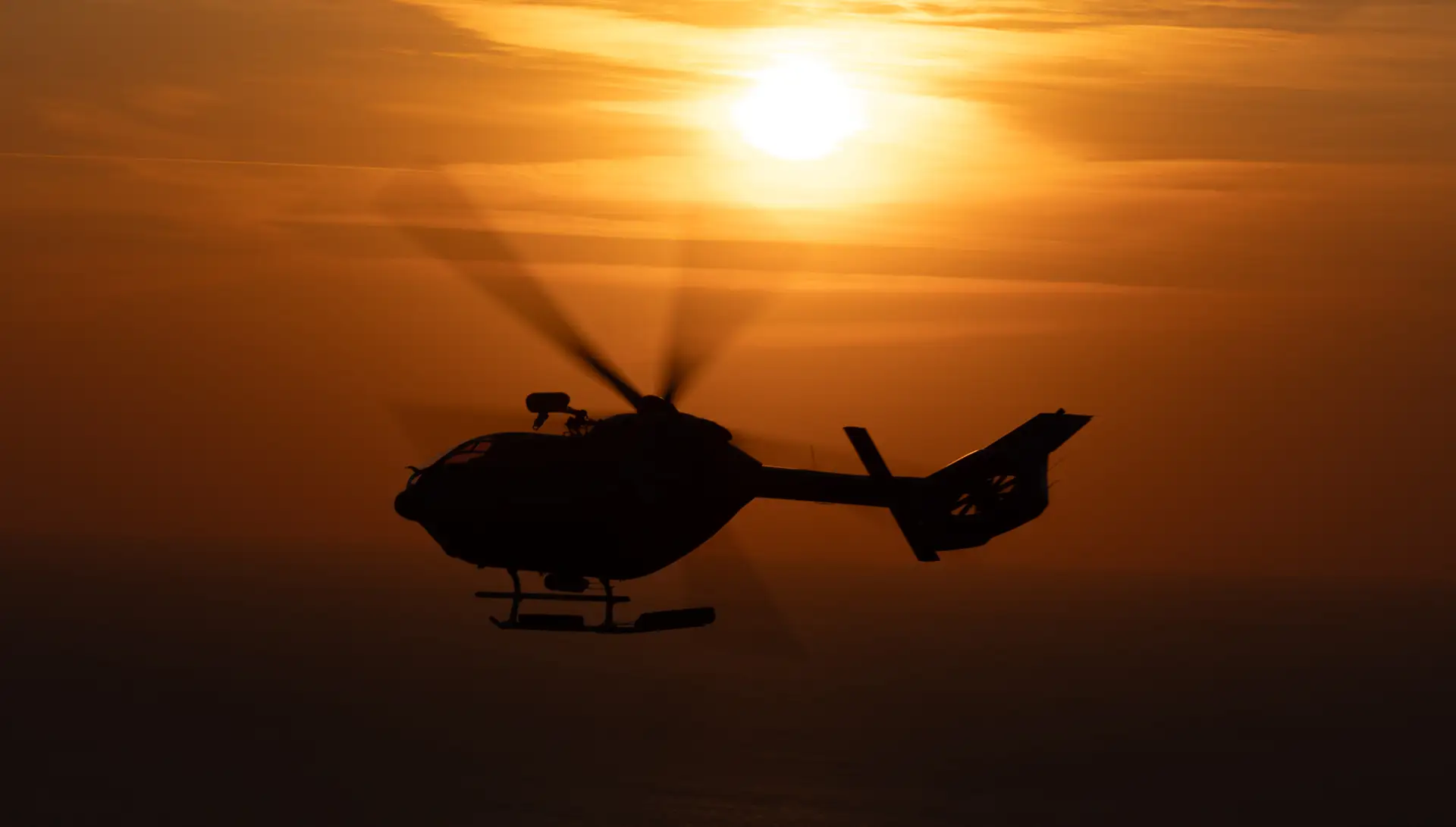
Granhoj stated that she is happy with where the company is at present but that they are always looking ahead and considering what they would
like to see the future hold. “There are more windfarms to be established in the Baltic as well as several more in the North Sea, including a
very large new farm to the west of Denmark that’s still in the planning phase,” she pointed out. “The EU is now pushing for more investment
in windfarms and we have looked at Europe and Scandinavia, but there are no immediate plans for us in that direction yet.”
Kjeldahl believes the future is looking positive and commented, “I have a belief that helicopter operations are best run locally. I can see the potential for having more helicopters and business here in this area, and it's that potential that I’d love to tap into. Our customers can see what we deliver, they get the benefit of having an aircraft because the way we do things makes it work for them and I think that is what will secure our future.”
“We take no shortcuts, and we don’t just deliver a helicopter. We deliver solutions and highly qualified, experienced people who work with our customers to solve things for them,” concluded Granhoj.
 HOME
HOME